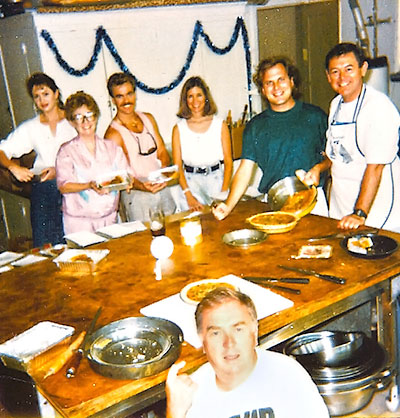Eat, Meditate, Love
More than two decades ago, in the midst of the burgeoning AIDS epidemic, Guy Blume worked in a kitchen that provided nutritious food everyday for those, mostly young men, afflicted by the disease. When he stumbled upon meditation practice, he says it was like finding “water in a desert.”
The beginning of the last decade of the 20th century was a distinctive time in America. An epidemic was decimating a sector of the population and there was no cure, nor any test for the disease, nor any certainty about exactly how the disease was transmitted. The disease was AIDS and the victims were mostly young men in the fullness of their lives.
I was the executive chef of Project Angel Food. It was a grand title for something that started out as an experiment executed out of a dilapidated kitchen in a rundown church. We were going to provide daily nutrition for people with AIDS. In 1990 it was all we could do to help the mostly young men that were dying. It was a terrifying epidemic with a 99% fatality rate. Death could come slow or fast but death always came.

Volunteers staffed the kitchen. It was filled with grieving mothers, fathers and lovers, Hollywood celebrities and young men who had recently been told they had the virus. We were all trying to understand what was happening.
Each day when I walked into that kitchen I was confronted with death, anger, hope, despair, joy, laughter and pain.
It wasn’t an ordinary job and it required compassion and coping skills that often felt beyond my abilities.
It was about this time that I discovered the Los Angeles Shambhala Center.
I was out for a walk after dinner one night with a friend, when we passed by the old center on 3rd Street. They offered a class on Tuesdays and I signed up.
I remember almost nothing about that class except that I received meditation instruction and that meditation was like water in the desert for me.
 I started meditating each morning for ten minutes. I had to set a timer to make sure I sat for the full ten minutes. Pretty quickly I begin to notice a difference in my life. I was more patient and kind, less reactionary. People commented on a change in me. My morning meditation became as important as my first cup of coffee.
I started meditating each morning for ten minutes. I had to set a timer to make sure I sat for the full ten minutes. Pretty quickly I begin to notice a difference in my life. I was more patient and kind, less reactionary. People commented on a change in me. My morning meditation became as important as my first cup of coffee.
Over the years my meditation practice became firmly rooted in my day and Project Angel Food grew till around 1996 it was serving 800 meals a day. We had moved out of the cobbled together kitchen in the church to a new facility full of shiny stainless steel refrigerators and appliances. 1996 was also the year that new drugs came on the market, the protease inhibitors, a combination of antiretroviral drugs that effectively stopped the virus from replicating. The results were dramatic.
I’ll never forget the week one of our board members, a doctor, told me it was the first time that none of his patients were in the hospital.
Infected individuals began to realize that they were going to live and began planning a different kind of life, not defined by illness.

The dharma is practical. Meditation was the thing that I needed to take care of myself so I could take care of others. Birth, sickness, old age and death are the inevitable suffering that we face as human beings. The Buddha stated it in the first noble truth, but he also told us that there was a way to escape the suffering, that there was a path of cessation of suffering known as the eightfold path which includes right mindfulness or meditation.
I don’t know if I could have made it through those years without meditation.
Death and sickness aren’t insane but our perceptions of them are.
Meditation was the sanest thing I could do for myself and I am grateful that it was the light that guided me through a challenging time.
———–
 Guy Blume has been a Shambhala Buddhist practitioner for 20 years. He is a meditation instructor, a kado practitioner and a member of the Madchen Corp, who serve as personal cooks to Sakyong Mipham Rinpoche. He is also the regional head of Culture and Decorum. Guy is also a graduate of Parsons School of Design. In 2009 he formed his own interior design company where he incorporates the principles of the Five Buddha Families and Matri Space Awareness into his work.
Guy Blume has been a Shambhala Buddhist practitioner for 20 years. He is a meditation instructor, a kado practitioner and a member of the Madchen Corp, who serve as personal cooks to Sakyong Mipham Rinpoche. He is also the regional head of Culture and Decorum. Guy is also a graduate of Parsons School of Design. In 2009 he formed his own interior design company where he incorporates the principles of the Five Buddha Families and Matri Space Awareness into his work.
